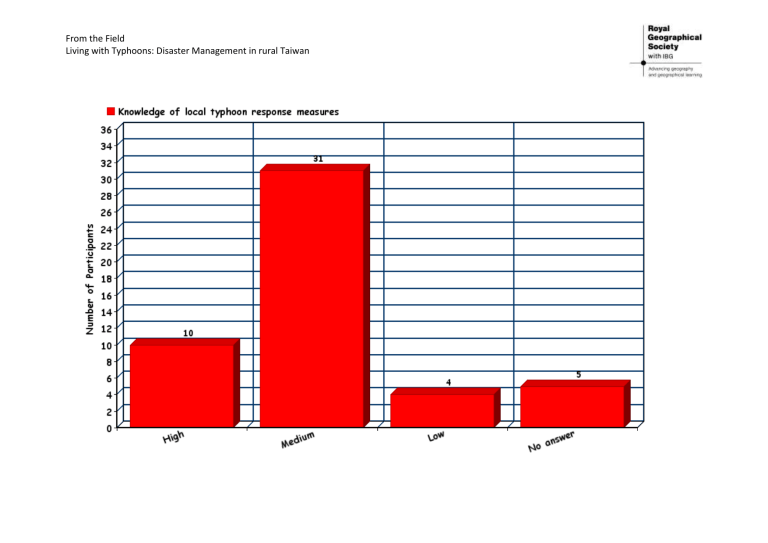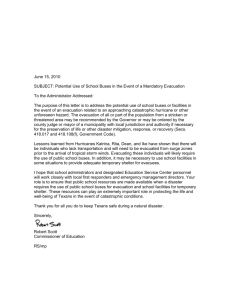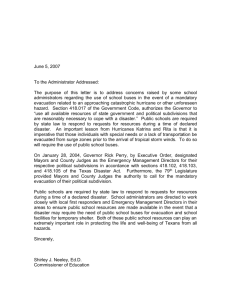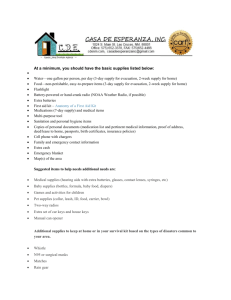From the Field Living with Typhoons: Disaster Management in rural

From the Field
Living with Typhoons: Disaster Management in rural Taiwan
From the Field
Living with Typhoons: Disaster Management in rural Taiwan
From the Field
Living with Typhoons: Disaster Management in rural Taiwan
From the Field
Living with Typhoons: Disaster Management in rural Taiwan
From the Field
Living with Typhoons: Disaster Management in rural Taiwan
From the Field
Living with Typhoons: Disaster Management in rural Taiwan
Evacuation is currently only ordered after 250 mm of precipitation. Considerable difficulties may arise if local residents don't evacuate the area until after
250mm of rainfall has fallen. Roads which at night will be in darkness may be blocked or washed away, and any body of people moving through the valley, or up the mountain to the evacuation centre in the midst of a typhoon would be more vulnerable and exposed to danger as a result. It is integral if a successful evacuation of local resident's is to succeed that all areas of human habitation are evacuated before the onset of any typhoon activity and not after.
The evacuation centre (a school) for Maya village consists of two buildings (Fig. 52). The first building has large glass windows on four sides which would render it extremely dangerous in the event of a major typhoon. As it is unlikely that another suitable evacuation centre could be found within the area it is a recommendation that the majority of human evacuation activity should be conducted in the second building and not the first. The evacuation centre in
Dakanua is at the bottom of extremely steep slopes that is prone to landslides (Fig. 53.). In addition, land above the evacuation centre has been planted with betel palm trees and the shallow root systems of these trees is believed to contribute to soil erosion, flooding and increase the severity of landslides..
Subsequently it is recommended that a new evacuation centre is found.
In Taiwan the Soil and Water Conservation Bureau (SWCB) decide which area is most susceptible to debris flows and issues hazard risk maps and hold training courses teaching local residents the difference between the red (compulsory) and yellow (non-compulsory) evacuation alerts.
(Mandatory evacuation is only enforced when the current precipitation levels surpass precaution levels. The precaution levels in Namasia and Maolin is
250mm). Creating hazard maps can be an effective form of risk communication but only if the population they are designed to assist can read and properly interpret them. The marking of high risk areas, assembly points, rest centres, and critical infrastructures are required to make the hazard map effective. At the national level, hazard maps are produced by a variety of different departments in charge of each individual hazard. As noted the SWCB is responsible for debris flows, the Ministry of Agriculture is responsible for landslides and the Ministry of Economics is responsible for flood hazard maps etc. Under The
Disaster Prevention and Protection Act, local authorities are also required to produce hazard maps. (Radio Taiwan International 2012) reported that a number of criticisms of some of these maps which include (1) the indicators were not clear on the maps; (2) no clear road names, evacuation routes and directions.
However by far the greatest problem, despite being an overtly complicated system of disseminating information there is also a distinct lack of a sharing mechanism between different organisations. (Community hazard maps were only shared by the National Fire Agency since June 2012) (Ministry of the
Interior 2012). Here it is evident that if a universal disaster management body was in place with the responsibility of producing all disaster related mapping, the processes for disseminating information would clearer, and it is likely finances and resources would be saved and a greater number of affected residents would be assisted.
From the Field
Living with Typhoons: Disaster Management in rural Taiwan
For those six participants who did not leave their houses, their responses to the research indicated that they were reluctant to leave their homes and/or didn't think the storm would be so heavy. In one instance the participant stated that he was not told about evacuation procedures (it can be concluded that the participant possibly lived in an isolated dwelling away from the main body of the other villages).
These intransigent actions can probably be related to the fact that the six participants were all aged over 50 years of age and as Perry (1979) argued held opinions or views of particular ‘traditional’ nature. Of the 50 people asked 28 did not answer or stated that they were not aware of any contingency plan for vulnerable persons during Morakot. Of the 23 people who replied in the affirmative that they were aware of contingency plans for vulnerable people it is unknown whether or not these contingency plans were in place during Morakot or have been subsequently put in place.
The communities of Namasia did not report a particularly good understanding of the hazard maps (and one would assume the associated hazard risks) with only 5 participants of the 50 fully understanding a hazard map. Again these findings support Wu's conclusions. In relation to question 14, 'what changes would you like to see?' the participant’s answers were varied encompassing a variety of different viewpoints. Answers centred on establishing more cooperation between local people and government authorities, a greater understanding of the dangerous features and increased awareness of how to prepare in advance for major typhoons and improved evacuation procedures.





